|
|
Updated as per "Systematics of moths in the genus Catocala (Lepidoptera, Erebidae) IV.
Nomenclatorial stabilization of the Nearctic fauna, with a revised synonymic check list";
ZooKeys 39: 37–83 (2010) by Lawrence F. Gall, David C. Hawks; March 20, 2010
|
Catocala faustina allusa
kah-TOCK-uh-lahmmfows-TEE-nuhmmal-LEW-suh
Hulst, 1884
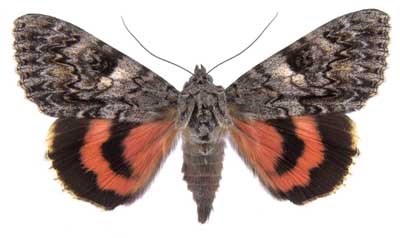
Catocala faustina allusa, British Columbia
This site has been created by
Bill Oehlke at oehlkew@islandtelecom.com
Comments, suggestions and/or additional information are welcomed by Bill.
| TAXONOMY:
Superfamily: Noctuoidea
Family: Noctuidae
Group: Noctuinina
Subfamily: Catocalinae
Genus: Catocala, Schrank, 1802
| |
MIDI MUSIC
"Moon River"
copyright C. Odenkirk
MIDI CITYON.OFF
<bgsound src="moon.mid" LOOP=FOREVER>
|
DISTRIBUTION: Catocala faustina allusa
flies in the Pacific Maritime Ecozone of
British Columbia
and southward into Washington
and northern California
(near Hallejuh Junction, Lassen County). It also
flies in Oregon (Clackamas County) and possibly western Nevada (near Reno).
It is confirmed in Idaho and Montana.
Moths previously designated as allusa are now (2010) classified as Catocala faustina allusa.
This specimen, courtesy of Jeremy Tatum and Dr. John Snyder, shows
typical resting pose. According to Jeremy, the moth was "immediately
active as soon as it had emerged from the pupa, and it would not
allow me to photograph the hindwings, which are quite similar to
those of aholibah."
White interior outline of terminal line is typical of this species
and two jagged upper "teeth" of postmedial line are typical of most
poplar feeders. There is also a dark bar a few mm up from inner
margin of the forewing.
The inner black band of the hindwing is relatively thick and
terminates well before the inner margin.
| 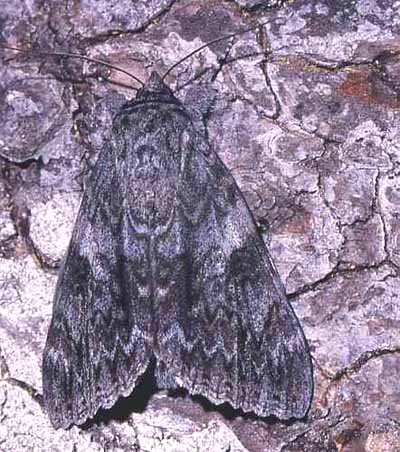 |
Specimens from the coastal areas of northern California, Oregon,
Washington and British Columbia are classified as C. faustina allusa.
C. faustina allusa blends with C. faustina cleopatra
in northwestern California, and with C. faustina faustina in the Rocky Mountains of
Idaho, Wyoming and Montana.
The moth described as Catocala frenchii Poling, 1901, is a synonym of Catocala
faustina allusa.
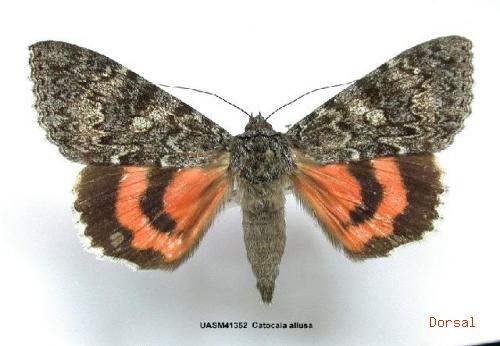
Catocala faustina allusa All Leps Barcode of Life.
FLIGHT TIMES AND PREFERRED FOOD PLANTS:
Catocala faustina allusa are usually on the wing in July-August.
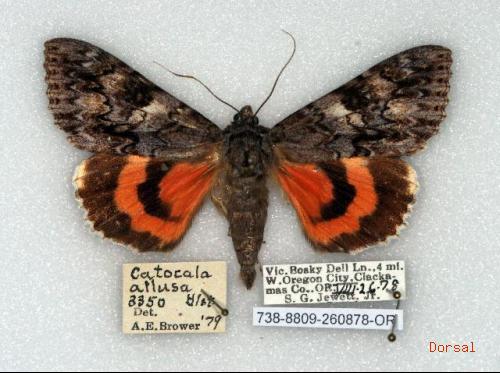
Catocala allusa, Oregon, All Leps Barcode of Life.
The Catocala faustina allusa caterpillar shows a preference for poplars
and willows.
ECLOSION:
Adults eclose from pupae at soil surface.
SCENTING AND MATING:
Catocala faustina allusa females
emit an airbourne pheromone and males use their antennae to track the
scent plume.
EGGS, CATERPILLARS, COCOONS, AND PUPAE:
Eggs are deposited on
tree bark in the fall and hatch the following spring. First instar
larvae are very tiny. As larvae mature they become night feeders, often
leaving the host plant during the day to hide amongst the undergrowth.
Catocala allusa larva on willow courtesy of Jeremy Tatum and Dr. John Snyder.
|
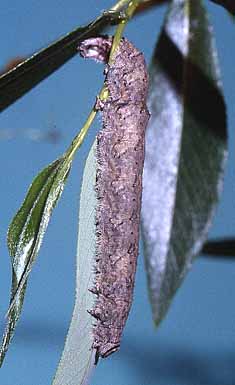 |
Larval Food Plants
Listed below are primary food plant(s) and alternate food plants.
It is hoped that this alphabetical listing followed by the common
name of the foodplant will prove useful. The list is not exhaustive,
although some species seem very host specific.
Experimenting with closely related foodplants is worthwhile.
Populus......
Salix
|
Poplar
Willow
|
Return to Main Index
This page is brought to you by
Bill Oehlke and the
WLSS. Pages are on space rented from Bizland. If you would like
to become a "Patron of the Sphingidae/Catocala Sites",
contact Bill.
Please send sightings/images to Bill. I will do my best to respond to
requests for identification help.




